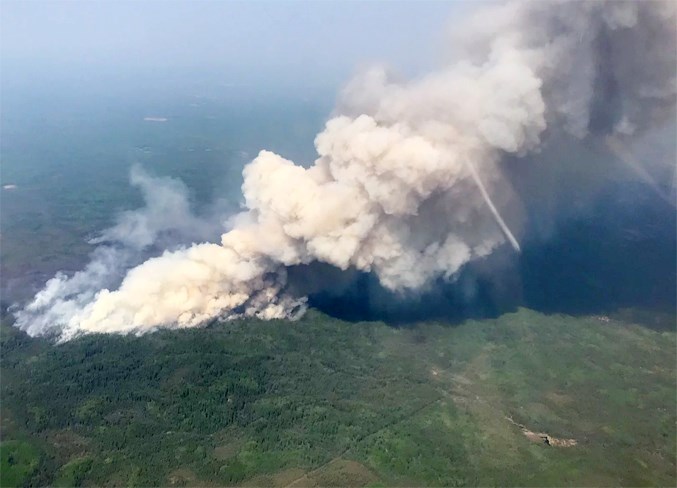As the northern half of the province faces wildfires consuming tens of thousands of hectares, both the Town of Athabasca and Athabasca County have issued fire bans.
The county upgraded their previous fire restriction to a full ban May 23, while the town declared a total ban May 21.
County emergency services director Ron Jackson said the ban was issued due to the fires north of Athabasca, and he noted surrounding counties were also declaring bans.
“We’ve had no precipitation; it’s extremely dry. The wind has been above average, and so the fire hazard is extreme,” Jackson said. “It only makes sense to escalate the fire restriction to a full ban.”
A situation update from the province May 26 stated the Chuckegg Creek Wildfire is burning about three kilometres southwest of the Town of High Level in Mackenzie County, reaching 105,000 hectares in size. It stated that evacuation centres had registered about 4,300 people as of May 26 at noon.
“Communities in the north of the province may experience heavy smoke from the fires in the next 24 hours,” it states.
Slave Lake area fires
In a May 27 interview, Slave Lake forest area wildfire information officer Leah Lovequist said the Slave Lake Wildfire 49 — located about 40 kilometres southwest of Wabasca-Desmarais and 40 kilometres northeast of Slave Lake — was the second-largest wildfire in the province, having burnt through about 40,752 hectares by May 26.
A May 29 update stated the fire had burnt through 74,506 hectares.
The fire is one of two in the “McMillan Wildfire Complex” located north of Highway 754, Lovequist said, noting it started May 18.
“It did experience some active fire behaviour, so some intense fire behaviour on the northeast and southwest flanks with the wind change yesterday,” she said May 27.
Lovequist said the McMillan Wildfire Complex has led to temporary closures on Highway 754, but it is not near any communities. She said people in the area should dial #511 or visit 511.alberta.ca for traffic updates.
“Very smoky conditions,” she said. “With all the fires in Alberta, smoke is going to be an issue.”
North of the McMillan fire, the Peerless Trout First Nation issued an evacuation alert May 26, noting that another fire had started up 14 kilometres southeast of the community of Trout Lake and “the public should be prepared to evacuate on short notice.”
“Be prepared to evacuate on short notice and follow the directions of local authorities,” the alert states. “Visibility will be poor in certain areas so caution must be used. The public should remain inside, limit exposure to smoke and seek medical attention if you experience breathing difficulties.”
Lovequist said the fire — located northwest of Wabasca-Desmarais — was exhibiting “aggressive fire behaviour.”
“As the evening came, the dark cool temperatures, the fire behaviour became significantly less,” she said, noting that air tankers and helicopters were on route May 27.
According to the Alberta Wildfire status map, the fire started May 26 at 5:56 p.m. Lovequist said it was 251 hectares May 27. By May 29, the fire had grown to 2,088 hectares.
Lac La Biche area ban
The northern and western portion of Athabasca County lies in the Lac La Biche forest area, which has been under a fire ban and off-highway vehicle restriction since mid-May.
A May 28 fire update states the wildfire risk is extreme, noting all fire permits are suspended and no new fire permits will be issued. It also states there is a red flag weather warning in effect for May 29.
The update also states the ban prohibits all open fires including campfires in campgrounds, back country and random camping areas and backyard fire pits; charcoal briquettes, turkey fryers and tiki torches; and fireworks and exploding targets.
It states the use of off-highway vehicles for recreational use on all public lands is prohibited. OHVs are allowed for industrial use, agricultural use and traditional use by Indigenous peoples, and use on private lands is also permitted.
An “off-highway vehicle” is defined as a motorized vehicle designed to go beyond defined roadways, including quads, side-by-sides, dirt bikes, 4x4 Jeeps, pick-up trucks and sport utility vehicles.
The update states portable propane fire pits, gas or propane stoves and barbecues designed for cooking or heating and catalytic or infrared-style heaters are also allowed.
Town and county bans
In a press statement, the county said the ban will remain until conditions improve. The county had issued a fire restriction May 17.
The county’s fire ban prohibits all open fires and suspends existing fire permits. It also prohibits:
- Recreational fire pits
- Burn barrels
- Fireworks and exploding targets
- Charcoal barbeques
- Gas and propane appliances for cooking and warming are still permitted.
The Town of Athabasca’s ban suspends use of public park fire pits and prohibits outdoor fires, fireworks, cooking fires, briquette barbecues and portable fire pits.
For more information on the bans, albertafirebans.ca provides up to date information on their status.
— Written by Allendria Brunjes & Will Gordon



